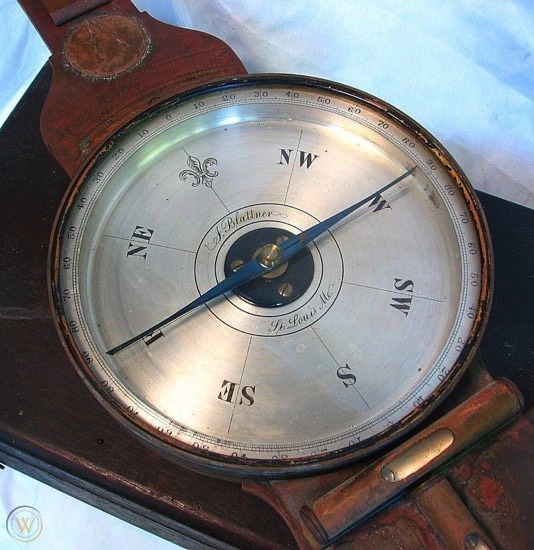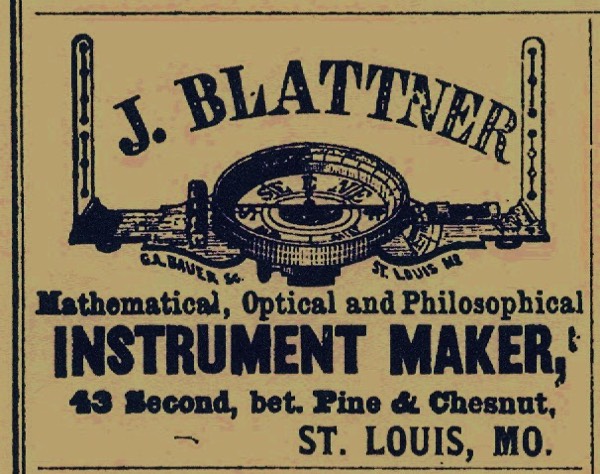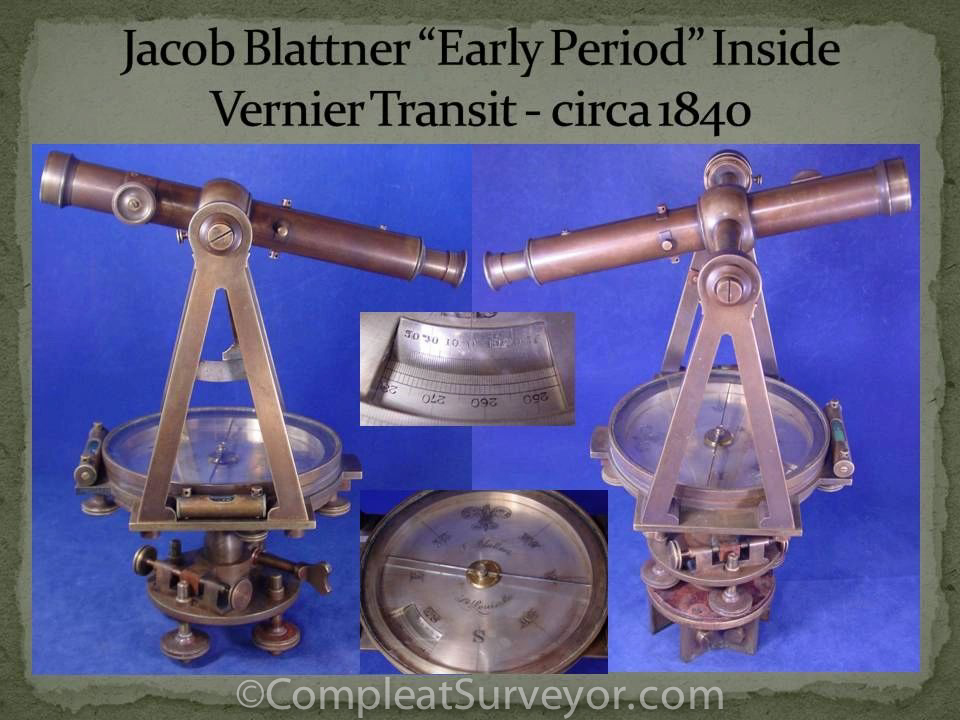
Blattner
History
JACOB BLATTNER
Jacob Blattner was born in Berne, Switzerland in 1812 and died in St. Louis, Missouri 1888. He arrived in St. Louis around 1839 by way of the port of New Orleans. It is probable that he made instruments in Switzerland before coming to America as he brought, in addition to his own family, his foreman and foreman's family. He was in business from circa 1840 to 1872. Upon his retirement in 1872 the business was carried on by his son Henry and his son-in-law Frank Adam, under the firm name of Blattner & Adam."
Jacob Blattner (1812-1888, life)
Jacob Blattner was born in Berne, Switzerland on May 21, 1812. He was thoroughly trained in his homeland in the art of manufacturing precision instruments. He immigrated to New York City sometime in the 1830’s and married Maria Kleiber in the German Reformed Church of New York City on December 19, 1836. The couple returned to Switzerland where Jacob probably pursued his craft. In 1839, Jacob and his wife, along with his foreman and his foreman’s family immigrated to the United States. The group traveled by ship to New Orleans and presumably by riverboat to St. Louis. The voyage from Europe was not uneventful. The Blattner’s daughter, Louisa M., was born September 29, 1839 on the high seas en route to the United States.
Blattner opened a shop at 24 Chestnut and was first listed in the St. Louis City Directory in 1840 as a mathematical instrument maker. This address was next door to where Charles Ryhiner was doing business in the same trade in 1839. It is unknown whether the two men knew each other previously. One may speculate that Blattner may have bought out Ryhiner, for after 1839, Ryhiner is not listed in the city directories.
Jacob Blattner’s business grew, prospered and expanded in scope during the following years. Only two years after opening his shop he won a silver cup at the St. Louis Mechanics Fair. An 1850 full-page ad listed Blattner as a maker of mathematical and surgical instruments, a dealer in guns, pistols and sporting materials and offered a repair service “...at short notice in the best manner.” Some of the items listed in the ad included surveyor’s compasses, chains, leveling instruments, pocket compasses, spy-glasses, barometers, thermometers, hydrometers, drawing instruments, spectacles, scales, protractors, hour glasses, microscopes, magnifying glasses, and magic lanterns. He also carried a line of non-mathematical and non-optical goods such as dental instruments, dissecting cups, syringes, lancets, forceps, tailor’s shears, druggist scales, powder flasks and game bags.
In an illustrated catalog published after 1867, Blattner offered a large range of surveyor’s compasses. They included a plain compass with a 4” needle and 12-1/2” plate selling for $30.00 ($365 in 2000 dollars) and a top-of-the-line vernier compass with a 6” needle and 15-1/2” plate for $50.00 ($610 in 2000 dollars). Also offered was a railroad compass with a fully divided circle outside the compass-box with two one-minute verniers for $80.00 ($975 in 2000 dollars). According to the catalog, this configuration “...gives the surveyor the power of laying off the variation of the needle, while the graduated circle enables him to take horizontal angle with great accuracy and minuteness, entirely independent of the needle.”
Repair service was an important part of Jacob Blattner’s business. His catalog stressed “particular attention paid to repairing and adjusting instruments.” We know the Surveyor General for Missouri and Illinois, Meriwether Lewis Clark (son of William Clark of Lewis and Clark fame), was a Blattner customer. Mr. Lewis mentions in a letter to his son “Lewdy” that he was “...having some alterations made to my instrument at Mr. Blattner’s shop....”
Another service offered by Mr. Blattner was special ordering. His catalog stated that he was willing "...to furnish on short notice any piece of apparatus, illustrated or described in the catalogues of other maker or dealer, though it may not be specified in this catalogue."
Jacob Blattner was in business in St. Louis for 33 years. During this period his business was located at least in eight different locations. Four of these changes of location took place in the time span between 1840 and 1854, a period of economic growth and expansion in the United States. One may assume these relocations were the result of needing bigger and better quarters as the business became established and grew. In 1857 the Blattner shop moved to 43 North 2nd Street, a location previously occupied by Mr. Blattner in 1853. This may have been in response to the sharp economic downturn brought about in the Panic of 1857. During the Civil War the shop was on Market Street and in 1868 it was relocated to 220 North 2nd Street where it was to remain through the rest of Jacob Blattner's tenure and also through out the existence of the successor company, Blattner & Adam.
Jacob Blattner, as were most members of the German-American community in St. Louis, was a staunch Unionist. He was probably a member of Blake’s militia, for he enlisted as a private in Company C, 3rd Regiment, U.S. Reserve Corps, Missouri Volunteers on May 8, 1861. Two days later the Missouri Volunteers surrounded and captured the encampment of southern sympathizers at Camp Jackson outside of St. Louis, which was instrumental in keeping Missouri from seceding from the Union.
Jacob and Maria had at least two other children besides Louisa. Daughter Mary Margaret was born August 19, 1843. She married during the Civil War, was widowed, and later married Theodore Henry Kleinschmit, who became prominent in Montana history. Jacob and Maria also had a son, Henry, who was to continue the business with Louisa’s husband, Frank Adam after Jacob’s retirement.
Jacob’s retirement was forced upon him in 1872 by failing eyesight. The business was turned over to his son Henry and his son-in-law Frank Adam. They continued at the same address on North 2nd Street doing business under the name of Blattner & Adam. Jacob’s early retirement went well. He had been successful in business and had accumulated enough money to live comfortably. He had a two story brick home at the southwest corner of Mississippi Avenue and Rutger Street. But apparently by 1877 he must have become restless in retirement and took a job as a machinist for G.B. Allen & Company.
This return to work was short lived however as his health continued to fail. He went to see Doctor Louis Hauck and was treated for “anaemia of the brain,” which would probably be considered depression today. His eyesight worsened, which he corrected with powerful glasses, but he now had problems with black spots. A partial recovery was affected; however, he continued to show signs of eccentricity for the remainder of his life.
Jacob’s health stabilized for a period of time but by the mid-1880’s began to deteriorate again. His eyesight was becoming worse and blindness was inevitable. His doctor stated in a newspaper interview, “Frequently, while walking along the street, he would have to grasp at some object for support.” He was troubled with insomnia and increasing depression. Jacob told his doctor on Monday, November 12, 1888 that “he was an old man, and had lived his time, and if there was no hope that his conditions would become better he wished that death would relieve him of his sufferings.”
On the morning of November 15, 1888 at 7:00 am, Mr. Blattner’s housekeeper went to wake him. She found him lying on the floor with a revolver by his side. She immediately sent for his son Henry, son-in-law Frank and Doctor Louis Hauck. The Doctor later told the papers, “When I arrived his body was still warm and he could have not been dead more than three quarters of an hour. The bullet had pierced the heart and he had suffered no pain, death being instantaneous.” The Post-Dispatch stated “The theory of his relatives is that he was unable to sleep last night and restlessness and worry put him in such a condition in a moment of despair he resolve to end his life.”
Thus ended the career of one of St. Louis’s earliest, most prolific and very talented instrument makers. The Globe-Democrat said of him “Mr. Blattner was one of the early merchants of St. Louis and quite widely known and respected generally.” A modern scientific instrument restorer has said of Jacob Blattner’s work “the hand engraving on compass face, circle and vernier was the work of a master.”
Labels

Articles
Additional Pictures

© 2020 Russ Uzes/Contact Me